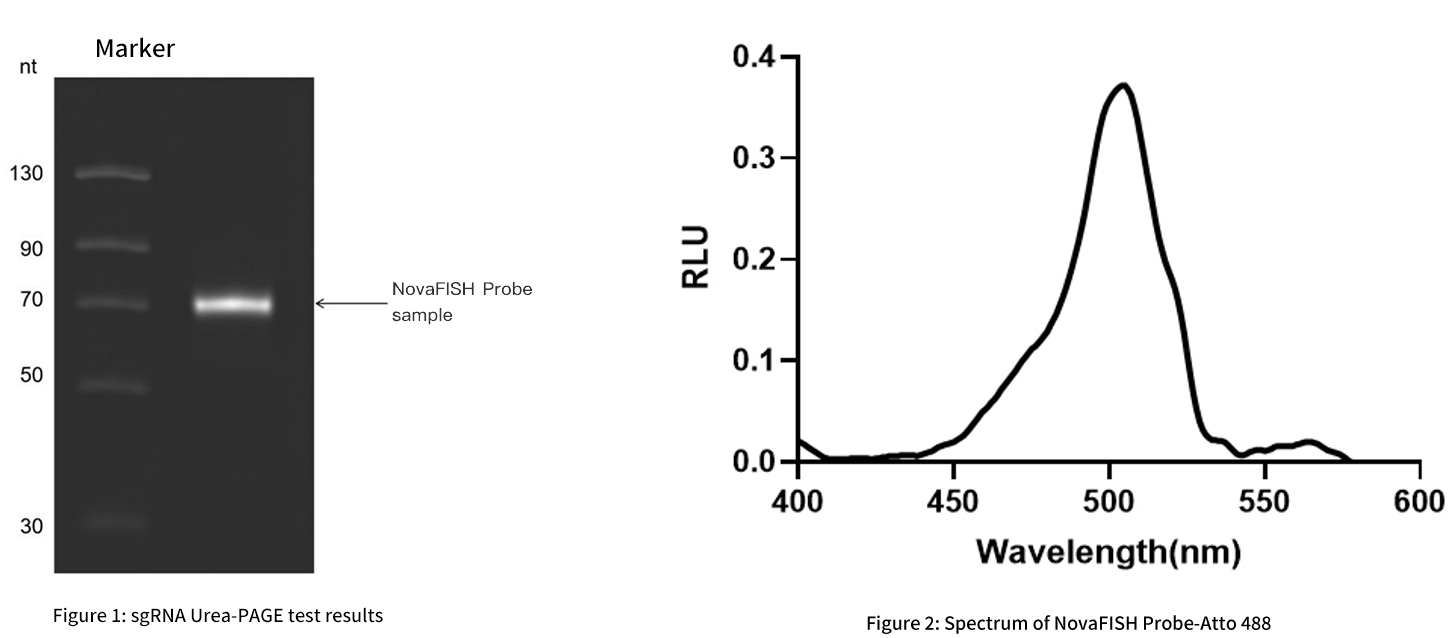Our NovaFISH probes can completely be customized based on any gene sequence you choose.
This NovaFISH kit includes NovaFISH probes and other necessary consumables to get you started immediately.



NovaFISH is a novel single-molecule FISH (smFISH) technology based on the innovative drug model intelligent synthesis platform (nMECA), enabling each probe to be labeled with multiple color combinations simultaneously. This enzymatic synthesis method not only reduces costs but also significantly enhances staining effects. The multiplexed NovaFISH probes can detect the expression of 7 genes in a single hybridization process, and with microscopes utilizing more channels, they can detect 7 to 100 genes.
As the number of spectrally separable fluorophores increases, the diversity of NovaFISH grows exponentially. This means that more probes of different colors can be used in the same sample, allowing for the simultaneous detection and distinction of more target sequences or structures. This increase in diversity will provide more comprehensive and accurate information for chromosome structure research and clinical diagnostics.
The complexity and diversity of biological systems present challenges for gene expression research. The redundancy and complexity of biological systems cannot be overlooked when exploring genes related to specific pathways or searching for biomarkers. In such cases, biological markers with multiple signals can significantly improve the accuracy of research. In situ methods like NovaFISH are essential tools that provide real expression patterns with spatial information, helping us understand the functional mechanisms of various genes.
By using multiple signals, we can obtain more comprehensive information and better understand the functions and regulation of biological systems. A single signal may not fully reveal the complexity of gene expression, as there are interactions and regulatory relationships between genes. By using multiple biomarkers, we can simultaneously observe different genes and understand their spatial and temporal expression patterns. This helps us comprehend gene interactions, regulatory networks, and cellular functions.
Furthermore, multiple signals provide important validation and confirmation functions. Detecting multiple markers in the same sample allows for the consistency of research results to be verified and potential interference factors to be eliminated, ensuring the reliability and accuracy of the research.

Compared to traditional fluorescently labeled probes, enzymatic synthesis probes offer the advantage of signal amplification by enzymes, thereby enhancing detection sensitivity.
NovaFISH uses multiplex probes capable of simultaneously detecting multiple gene expressions. This allows for the acquisition of multiple gene expression data in a single hybridization process, greatly improving the efficiency of high-throughput analysis.
The diversity of NovaFISH grows exponentially with the increase in available fluorescent dyes. This means the number of genes that can be simultaneously detected will grow exponentially with the types of dyes, making broader gene expression analysis possible.
Single-molecule FISH technology inherently has high-resolution characteristics, allowing for the detection and localization of RNA or DNA molecules at the single-molecule level. NovaFISH uses enzyme-labeled probes, further enhancing detection sensitivity and resolution, making gene expression quantification and localization more precise.
Compared to other cascade amplification technologies like RNA scope, NovaFISH is simpler and easier to operate in terms of sample handling, reagent use, time efficiency, equipment requirements, and technical complexity.
NovaFISH detects and quantifies individual RNA or DNA molecules at the cellular or tissue level, offering insights into gene expression regulatory mechanisms like transcriptional dynamics, cellular heterogeneity, and variability. At the single-molecule level, it reveals individual variations and complexities within gene regulatory networks in cell populations.
This method tracks and analyzes gene expression patterns during cell differentiation and development. By localizing and quantifying target RNA or DNA molecules in cell lineages, it reveals transcriptional differences and dynamic changes between different cell types.
By detecting and localizing abnormal expression of pathologically relevant genes, NovaFISH reveals molecular changes linked to diseases. Moreover, it can be used for disease diagnosis and classification, such as the identification of cancer subtypes and screening for molecular markers.
By detecting the expression of specific genes inside cells and signaling molecules in the extracellular environment, it reveals cell responses to external stimuli and signaling mechanisms.
We offer high-quality NovaFISH probes to meet your research and experimental needs. Our probes are meticulously designed and optimized, featuring exceptional specificity and sensitivity to ensure accurate hybridization and detection results. Utilizing the latest technology and stringent quality control standards, we guarantee the reliability and consistency of our probes. For example, in electrophoresis detection, a particular NovaFISH probe's size matches the prediction, displaying a single band without nonspecific bands. Additionally, the ATTO 488 fluorophore exhibits a single absorption peak at 504 nm (see Figure 2).

We welcome you to order our NovaFISH probes. Whether you need custom probe sequences, region-specific probes, or combinations of multiple site probes, we can design and produce them according to your requirements. Our experienced team can provide customized solutions to meet your unique research needs.
Please feel free to contact us for more information about NovaFISH probes. We look forward to collaborating with you and providing high-quality probes for your research.


